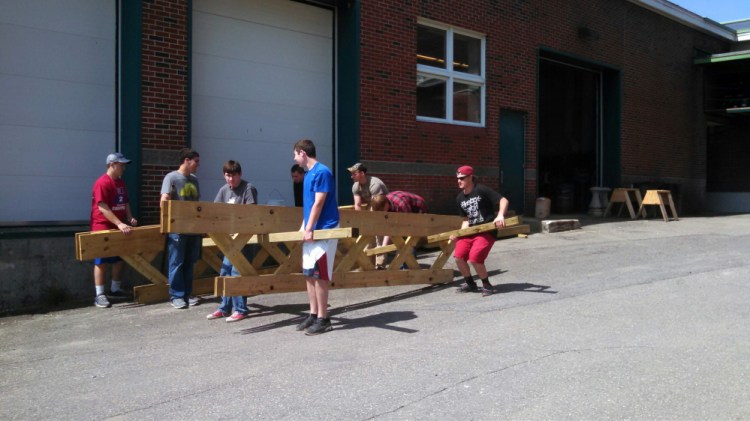This week, students at Messalonskee High School worked to improve the health of their peers by building a bridge to make a walking trail more safe.
With Maine schools lagging the nation in providing exercise opportunities during school hours, walking trails can play an important role in student health by capitalizing on the state’s culture of outdoors physical activity.
The Messalonskee School Trails, which include access points at the high school and Messalonskee Middle School, help encourage students to get moving, said Claire Heffernan, the school health coordinator for Regional School Unit 18.
“I think it’s always a concern that the kids don’t have enough physical activity,” Heffernan said. “They live in a world of a lot of electronics that they seem to get very involved in, instead of getting outside. One of my goals is to get the kids outside, get them walking.”
The trails enjoy heavy use by students and instructors alike.
“The students walk the trails. It gets them physically active. They snowshoe on the trails in the winter,” she said. “The teachers do a lot of environmental studies from the trails.”
As part of their lessons, students have also helped to upgrade and maintain the trails in other ways, including the design, construction and installation of signs at learning centers along the trails.
The school district’s focus on the trails may help to balance the fact that Maine’s schools don’t provide as much physical education as their counterparts across the nation.
In 2010, just 6.7 percent of Maine’s high school students reported having daily physical education, as compared to 30 percent nationwide, according to a 2013 report from the Centers for Disease Control.
The report gave Maine low marks for lacking a state physical education time requirement for high school students, among other factors that contribute to obesity.
But that’s not to say that Maine’s young people aren’t active.
They’re actually more active than students across the nation — it’s just that they’re getting their exercise in other ways.
In Maine, the report found that more than 22 percent of high school students were physically active, compared to about 17 percent nationally; that helps to explain why 11 percent of Maine’s high school students are obese, less than the national average of 12 percent.
Heffernan said her very presence demonstrates that RSU 18 has made health a priority. She said many school health coordinators have found themselves out of a job because of financial pressures created by the economic recession. The district includes Oakland, Belgrade, Rome, China and Sidney.
Part of what makes her part-time position tenable, she said, is her ability to secure grants that support health initiatives based on walking and improved nutrition.
“It’s so encouraging that there are grants and funding that will support the creation and improvement of our trails,” she said.
BRIDGE OUT
Heffernan worked to have the Messalonskee School Trails be included as part of a larger 40-mile trail system that runs through parts of Oakland, Waterville, Winslow, Benton and Fairfield. That system, Kennebec Messalonskee Trails, has been built over the past 10 years and has become a major asset to the community, according to area leaders.
Heffernan’s work to bring the school’s trails into that system made her aware of a problem with a damaged bridge that was built to provide safe access over a stream a short way into the woods from the high school.
“I realized the bridge was not anywhere near safe for traffic,” she said.
The gap was spanned by two previous efforts at bridges, one on top of the other.
When tractors carried logs over the bridge to other trail sections, the bridge sagged, creating a steep slope people could only “kind of shimmy down.”
Concerned that visitors could be hurt trying to use the trail, Heffernan applied for and received a grant from the Lowe’s Toolbox for Education grant program.
A team of students from teacher Bill Smith’s technology education class used each phase of the project as a lesson — students created drawings and architectural designs, worked out the needed weight and support structures and chose the materials and equipment they needed to make the bridge a reality.
The two-week project, which culminated with a ribbon-cutting ceremony on Tuesday morning, has brought the students into the center of a community effort that also includes school staff, local business donors and volunteers.
During the building phase, the students marked the individual parts so that the 1,000-pound structure could be assembled after carrying it to the site, about a quarter of a mile into the woods.
“They dodged raindrops and they piece by piece, put it all together,” she said.
According to the calculations of the students, the bridge can safely hold 5,200 pounds at a time — enough to handle not only foot traffic, but tractors and their payloads for trail improvement projects that may be dreamed up by future groups of students.
“Now,” Heffernan said, “it can be used by everyone.”
Matt Hongoltz-Hetling — 861-9287
Twitter: @hh_matt
Send questions/comments to the editors.



Success. Please wait for the page to reload. If the page does not reload within 5 seconds, please refresh the page.
Enter your email and password to access comments.
Hi, to comment on stories you must . This profile is in addition to your subscription and website login.
Already have a commenting profile? .
Invalid username/password.
Please check your email to confirm and complete your registration.
Only subscribers are eligible to post comments. Please subscribe or login first for digital access. Here’s why.
Use the form below to reset your password. When you've submitted your account email, we will send an email with a reset code.